|
|
|
|
An eBook and Website by Cyril J Wood
© March 2006
|
|
|
|
Introduction
Let’s get one thing straight from the start… as the title of this eBook and website points out… a narrowboat is not a barge. A narrowboat, as its name suggests is narrow, having a beam (width) of 6 foot 10 inches to 7 feet. Canal barges are between 60 and 70 feet in length depending on the canal they were built for. However, they are at least 14 feet 6 inches beam, are usually used for carrying cargo and are made from steel, wood or even concrete. Neither is a narrowboat a longboat. Longboats were what the Vikings used to convey them on their raping and pillaging voyages of discovery in the Dark Ages. The unenlightened amongst us will quite often confuse the three terms, much to the annoyance of narrowboat owners, canal enthusiasts and boat anoraks in general.
This is a barge... a Leeds and Liverpool Canal Short Boat to be exact...

... this is a Longboat (as used by the Vikings)...

... this is what, historically speaking is a narrow boat...

... and this is what is generally referred to today as a narrow boat
But this eBook is not just about narrowboat design but canal cruisers of all shapes and sizes. When discussing canal cruiser design where does one begin? It is undeniable that subjectivism will find it’s way into this aspect of the subject, after all... not everyone has the same taste in boats or views on a particular design or type of craft. If that were not the case we would all be cruising the canals in identical boats! Also, as far as hire craft are concerned, I have concentrated on one area, namely the Shropshire Union and Llangollen Canals as they are two of the most popular cruising canals in the country and also because this is the area that I know best. They also possessed many hire cruiser bases (including one of the first on the canal system – Inland Hire Cruisers of Chester - originally known as the Inland Cruising Association, established in 1935) and accordingly a wide range of canal cruiser designs. The most popular size of hire craft was the four berth design and unless otherwise stated, it is to be presumed that the craft being discussed is four berth. The hulls used for early canal cruisers came from a number of sources. The three most popular of which were... ex-working narrowboats, ex-War Department pontoons and retired lifeboats. Each type had size problems that made them less suitable for certain canals. The pontoons were only six feet in beam so seemed narrow compared to other craft. Ex-working narrowboats of seventy foot length could not be used on the Leeds and Liverpool Canal above Wigan with confidence as the locks on this and some of the adjoining canals were only sixty two feet long. The draft on these craft was usually more that two foot six inches which leads to problems on the shallower canals such as the Llangollen Canal which had a maximum recommended draft of one foot ten inches. One of the most famous of such a conversion was L.T.C Rolt's "Cressy" from which he wrote that timeless literary work "Narrow Boat".
Stork... a beautiful example of an ex-Cowburn and Cowpar narrowboat conversion

Two converted wooden lifeboats attending a boat rally on the Bridgewater Canal in the 1960's
The converted lifeboats were usually seven foot plus in beam which prevented them from using canals with narrow locks and were usually seen on the Leeds and Liverpool and Bridgewater Canals. Their hulls, like those illustrated in the photographs above and below were usually constructed from wooden planks laid "clinker" (vertically overlapping) fashion but some later examples like the one shown in the photograph below were made from steel.

"Flamingo" is a beautifully restored, clinker built, converted lifeboat

A more contemporary approach to an aluminium lifeboat conversion
Today, canal boats fall into two distinct categories... cruisers and narrowboats. In the 1960’s this was not the case. During this period there were many hire cruiser bases on the Shropshire Union Canal system. Inland Hire Cruisers and Deans Pleasure Craft both from Christleton, Sam Weaver’s Cambrian Canal Cruisers at Waverton, Jenny Wren and Egg Bridge Hire Cruisers (formally Weaver and Parry) also of Waverton, Beeston Castle Cruisers, The Golden Line boats based at Bunbury before Dartline (and later... Aquatravel... now Anglo Welsh), British Waterways Hire Cruisers and Nantwich Hire Cruisers (later Simolda) both of Nantwich Basin, Ladyline (also at Barbridge), Holidays Afloat and Watertravel from Market Drayton, Dartline’s sister company Shropshire Union Cruisers based at Norbury Junction, Countrywide Cruisers of Brewood, Double Pennant from Autherley, and many more companies lost in the mists of time (and memory).
Some of the craft from these companies remain in my memory for various reasons; the boats may have been “ugly”, poorly designed, had unique design features, had memorable crews or been involved in incidents of note. The materials that these craft were constructed from varied as well. The traditional boat building material of timber was represented in various guises including planked timber... both carvel and clinker as well as marine plywood, metals such as wrought iron and steel plus other less traditional materials such as glass reinforced plastic, aluminium and even concrete.
The more memorable craft from that era that come to mind are the “Water Gentian” and its twin "Water Lily" (British Waterways Hire Cruisers)… a converted 60ft narrow boat with a centre cockpit and wheel steering in the cockpit plus a tiller at the stern accommodating ten berths (featuring "real" rivets). Apparently, “Water Gentian” was very difficult to steer from the wheel and, as its size may imply, not very manoeuvrable. When travelling along the Llangollen Canal and the shallower sections of the “Shroppie”, it’s wash, even at slow speeds, had to be seen to be believed. British Waterways also had other converted narrowboats in their hire fleet but none were as big or as ungainly as “Gentian”. I have recently seen two surviving eight berth examples of their fleet in the shape of “Water Lupin” which I saw on the Llangollen Canal and “Water Lilac” which moors on the “Shroppie” near Nantwich. At the other end of the hire boat spectrum they had small two-berth ply-wood cruisers (possibly early Dawncraft) powered by outboard motors christened “Water Baby”, “Water Elf”, etc.

"Water Lily" - the twin to "Water Gentian" complete with genuine rivets!
(Photograph - British Waterways)

"Water Lupin" on the Llangollen Canal at Chirk
Another “steel monster” was Ladyline’s six berth “Lady Barbara”. This company usually utilised glass-fibre Freeman craft for their hire fleet but their first venture in steel was an abomination. Bluff-fronted, lacking grace and, as with “Water Gentian”, not very manoeuvrable (even though it was tiller steered) and also prone to creating a large wash in shallow water. It wasn’t a very large craft, being about thirty feet long but it’s poor design made it react like a much larger craft.
Deans of Christleton didn’t escape from the “monster” category, only their monsters were constructed in timber and not steel. They bought a full-length wooden butty boat (possibly an old Shroppie “Fly” boat) and cut it in two, fitted flat transoms to the sterns of both of the hulls, along with long cabins and Stuart Turner 8hp petrol engines. These six berth craft were christened “Clio” and “Orion” and were also as unmaneuverable and as underpowered as they were ungainly.

"Clio" and "Orion"... each was half of the same full-length wooden narrowboat
(Photograph - Dean's Pleasure Boats)
Like British Waterways, they also had small two-berth cruisers to compliment the range of craft available for hire. When we first started hiring craft from Deans in 1960, their two-berth craft was the “Ruby”, a diminutive 12ft boat that was replaced in 1965 by the “Susan”... an early ply-wood “Dawncraft” powered by an Evinrude outboard.

The diminutive "Ruby"
(Photograph - Dean's Pleasure Boats)

"Susan" was an early plywood Dawncraft
(Photograph - Dean's Pleasure Boats)

"Ursula" had an identical twin... "Mabel"
(Photograph - Dean's Pleasure Boats)
Other late craft built by them were the modern looking “Willeymoor” and “Newmarton”. These craft broke with Dean’s tradition by being named after locks on the Llangollen Canal rather than being given girls’ names as with the rest of the fleet. They were also the first of the fleet to have refrigerators and a pressurised water system.

"Newmarton" (or the identical "Willeymoor") when new in 1965
(Photograph - Dean's Pleasure Boats)

The sad sight of "Willeymoor" sunk at Runcorn in 1987
The early Simolda hire boats from Nantwich fell into the “down right ugly category”. They had no physical definition between the hull and superstructure except for a different colour of paint, in other words, they had no gunwales and the hull blended into the cabin sides separated only by a rubbing strake. Most of their craft were six berth and possessed names such as “Queen Ann 2”, “Queen Mary” and “Queen Elizabeth”. They later built narrowboats that also had distinctive trademarks like the unusual stern, front and rear sliding doors, odd shaped windows and curved roof-guards incorporated into the cabin’s leading edge. I think that Simolda used a boat from Holidays Afloat at Market Drayton as the pattern for their early craft as it also had no definition between the superstructure and hull. This was the “Jean”, a centre cockpit design with small portholes instead of windows. The “Jean” was featured in many of the photographs contained within the early British Waterways Cruising Guides on the Shroppie and the Llangollen Canals. The company later employed more conventional designs like the diminutive two berth “Drayton Dormouse” which was powered by an Evinrude outboard motor.
|
|
|
|
The "Jean" on Shebdon Embankment |
The "Dorothy" at Barbridge |
(Photographs - British Waterways)

"Dorothy" was one of two converted pontoons owned by Deans
(Photograph - Dean's Pleasure Boats)
Some of the older hire boats that plied the “Shroppie” were unusual too. Deans of Christleton had a boat called the “Dorothy”. This was a converted pontoon fitted with two cabins separated by a centre cockpit with the ubiquitous Stuart Turner 4hp engine below the cockpit floor. I Have recently learned from a colleague who’s parents hired boats from Dean’s that they had another converted pontoon. This came to light when my colleague brought some old family photographs in to show me and in some of the photographs the “Dorothy” (which her parents hired when she was a child in 1956) was accompanied by the second pontoon the name of which is unknown. I can also remember a couple of other converted pontoons. Beeston Castle Cruiser’s six berth “Skylark” (more of which later) and another which was owned, I think, by Inland Hire Cruisers of Christleton. When the “Dorothy” was retired from Dean’s fleet in the late 1960’s, coincidentally she was bought by a fireman also from Wallasey and moored above Beeston Stone Lock. Inland Hire Cruisers also had some notable designs… the “Espathea” was a double-ended, clinker-hulled, centre cockpit twenty two footer and was possibly a converted lifeboat. It also possessed an extremely rounded bilge beneath the water line which made it notoriously unstable and "rocky". As previously mentioned in “Canalscape Book 1” Chapter Four – Canalmanac 1962 to 1966, it sank at Llangollen and was subsequently repaired and re-floated. Some of their older hire craft like the “Bobby”, “Pat”, “Beryl”, etc were old Taylors dating from before the Second World War whose designs were definitely showing their ages. I remember one of their craft called “Enterprise”. This was a six berth cruiser about thirty five feet in length and built by Holt-Abbott... one of the renowned boat builders on the canal system in the early 1960’s. “Enterprise” was a success and a few more Holt-Abbots followed her into the fleet.

An old advertisement for Inland Hire Cruisers showing the "Enterprise" built for them by Holt Abbot

Dean's "Sheila" ("Shirley" was identical except for the front window shape)
(Photograph - Dean's Pleasure Boats)

|
Dean's "Maureen" shared the same design and dimensions as "Margaret" |
|
and "Peggy" differing only in the front window shape and other minor details (Photograph - Dean's Pleasure Boats) |
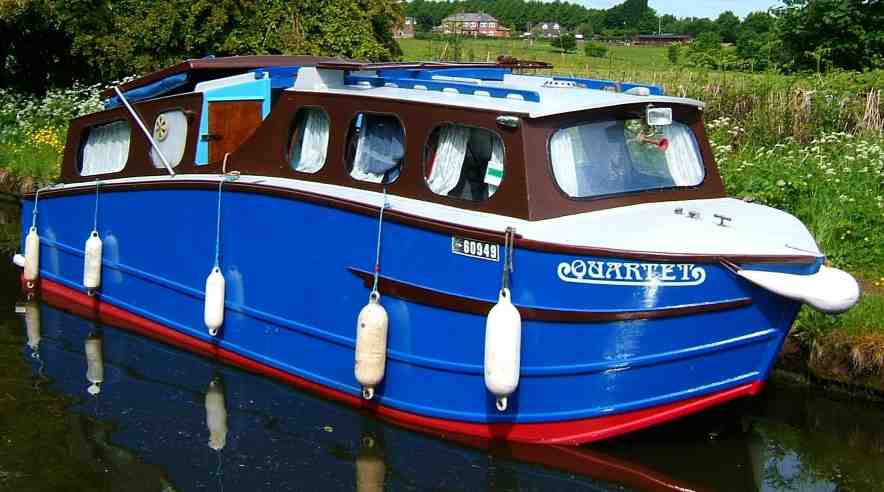
"Quartet" is a visitor from the River Weaver and is a similar design to Dean's craft but was actually built down south
Maid Line Cruisers are not based on the “Shroppie” or Llangollen Canals but occasionally, one of their craft finds its way to our neck of the woods. They have been involved in hiring canal cruisers since the mid 1950’s and on the Norfolk Broads and River Thames much earlier. When they were designing a craft for the canal side of the business they basically took one of their broad beam designs and shrunk it down to 6’ 10” beam. The resulting cruisers were launched in 1955 and even when surviving examples are seen today they are admired for their fine sweeping lines.
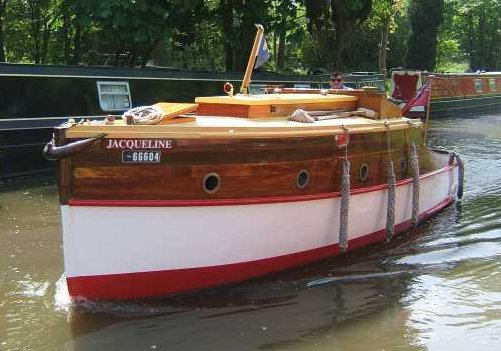
"Jacqueline"... a classic cruiser from the River Weaver is reminiscent of a pre-war Taylor
Both Dean’s and Inland Hire Cruisers’ boats (as well as many other hire firms) possessed Stuart Turner petrol engines almost exclusively. They were in various power ratings from two horsepower upwards. They were all two-stroke engines running on fifty-to-one petrol-oil mixture and these engines were renowned for their simplicity of design and their reliability. They were to the light weight cruiser what Listers were to early narrowboat conversions and new builds from the 70's and 80's.
There were many boatbuilders of the time that brought their own individuality to the canals. Some boats were beautiful, some were, as previously mentioned, ugly, some were ingenious in their design, some were converted from other craft such as ex-army pontoons or lifeboats. There was the occasional narrowboat conversion but these were in the minority, unlike today when purpose built narrowboats are in the majority. Whatever type of craft was seen, they were usually memorable in one way or another.
Sid Merral’s Beeston Castle Cruisers located at Beeston Castle Wharf (just below the Iron Lock at Beeston and now Chas Harden Boats) had a fleet of three six berth craft :- the “Skylark”, which was two pontoons joined together end to end and fitted with a pointed bow grafted onto the front, the “Starling” which was the front and rear of a full length narrowboat previously belonging to Cowburn and Cowpar... the famous canal carrying company cut into three pieces, the middle part of the original narrowboat hull was fitted with a bow and stern to became the “Swan”. All three craft had timber superstructures and Lister or BMC diesel engines. The “Swan” (now christened “Jacqueline Yvonne”) is privately owned was last seen moored on the Macclesfield Canal and “Starling” is moored on the Shropshire Union Canal at Knighton. I recently learned that the present owner of “Starling” wanted to purchase “Jacqueline Yvonne” in order to reunite the three pieces of the original craft. The owner of “Jacqueline Yvonne” would not sell her so the prospective buyer found another suitable donor craft, cut off the bow and stern and inserted the centre section to reinstate “Starling” to her original seventy foot length, fit a replica of the original boatman’s cabin in addition to replacing the BMC Commander engine with something more in keeping with the Gardner fitted to the boat when it was new.
|
|
|
|
Beeston Castle Cruisers' "Skylark" in 1967(left) and "Starling" in 1966 (right) |
|
|
|
|
|
"Swan" (left) in 1967 and in later life as "Jacqueline Yvonne" (right) at Lymm in 2002 (Photographs - James M Wood - except for bottom right) |
|
My favourite canal cruisers from the 1960’s era had to be the Taylor boats (like the “Kathleen”) built at Tower Wharf, Chester. They had splendid, graceful lines which were emphasised by the fact that the mahogany hulls and superstructure were usually varnished above the water line except for the hire boats. Some of them still survive.

J H Taylor's Boatyard in Chester
(The boat moored on the right is Gazelle)
The six berth “Amaryliss” (previously named “Teal”) has been painstakingly restored and is now a resident exhibit at the Waterways Museum, Ellesmere Port (previously known as The Boat Museum).

"Amaryllis" (previously named "Teal") at the National Waterways Museum, Ellesmere Port
(Photograph - National Waterways Museum, Ellesmere Port)
Jenny Wren Hire Cruisers at Waverton on the Shropshire Union Canal had a boat called (unsurprisingly) "Jenny Wren" which was stored and for sale in Taylor's Boatyard for many years, sadly looking a little the worse for wear and requiring a considerable number of her timbers replaced. She has since been bought by Mersey Television and was used as a garden shed in the Chester based television series “Hollyoaks”.
|
|
|
|
|
These three photographs show the Taylor built boat "Jenny Wren" during various stages of her life... as she was in 1986 (top left), in a sad state inside Taylor's Boat Yard in Chester, during 1995 and whilst being used as a prop in Chester for the television series "Hollyoaks" in 2003 (left) (Photograph bottom left - Mersey Television) |
There used to be a fine six berth example moored at Sale on the Bridgewater Canal christened “Barbara Joan” but it was in need of restoration and after being stored out of the water for a few years at Stretford Boatyard she eventually went to a specialist wooden boat restorer.

The Taylor-built "Barbara Joan" being stored at Stretford Boatyard being stored prior to restoration
Another... “Gazelle” (see the photograph of Taylor's Boat Yard in Chester) was one of the few aft cockpit versions built and was moored on the Trent and Mersey Canal but its present location is unknown. There are others at various locations throughout the canal system but their numbers are rapidly dwindling.

The "Kathleen" was a Taylor and our family's favourite
(Photograph - Dean's Pleasure Boats)

|
"Sai Wen 2" (later rechristened "Say When") was similar to "Gazelle" and "Beyond" and were unusual |
|
for Taylors inasmuch that they all had aft cockpits rather than the more usual centre cockpit |

A recent (August 2013) photograph of "Beyond" on the Trent and Mersey Canal
Deans Pleasure Boats bought three thirty foot Taylor wooden clinker hulls and fitted their own cabins. The prototype of the three was the “Elizabeth” and possessed graceful lines as would be expected from a Taylor hull. All were centre cockpit, six berth craft powered by eight horsepower Stuart Turner, twin cylinder engines. I remember seeing “Juliana” and her sister craft in Dean’s workshops at Christleton in 1965 having their superstructures being fitted. “Juliana” is now moored at Barbridge Junction and is looking in extremely good condition... a testament to her builders considering her age (over forty) and that she is an ex-hire boat. I did overhear a conversation were the boat was incorrectly described as a “Taylor”... I naturally had to correct them on this point. I don’t think that BW’s Certificate of Compliance or the Recreational Craft Directive specifications would look kindly on the original petrol fuelled Stuart Turners being installed today though.

"Elizabeth" differed only in minor detail to "Juliana" (below) and her sister
(Photograph - Dean's Pleasure Boats)

A recent photograph of Taylor hulled, ex-Dean's hire boat "Juliana" at her Barbridge mooring
In more recent times, Taylors built a few narrowboats like “Harmony” (moored at Agden on the Bridgewater Canal) which was used extensively in Granada Television’s programme “Travelling Man” during the mid-1980’s. The Taylor lines are evident in this craft like the well shaped hull and cabin profile... even down to the two small rectangular front windows (fitted at either at the front or rear) that was a Taylor “trademark”.

"Harmony" of Granada TV's "Travelling Man" fame was also built by J.H.Taylor of Chester
One of the first GRP boats that I saw was Sam Weaver's Cambrian. Sam built the boat himself at his Waverton boatyard in the early 1960's and it was so successful as a hire boat that he built a sister boat named Waverton that was also a hire boat. It is a tribute to Sam Weaver that over fifty years later the Cambrian is still going strong and is illustrated below passing through Lymm on the Bridgewater Canal in June 2017. It still has the original Stuart Turner engifitted and is normally moored above Kings Lock on the Trent and Mersey Canal at Middlewich.
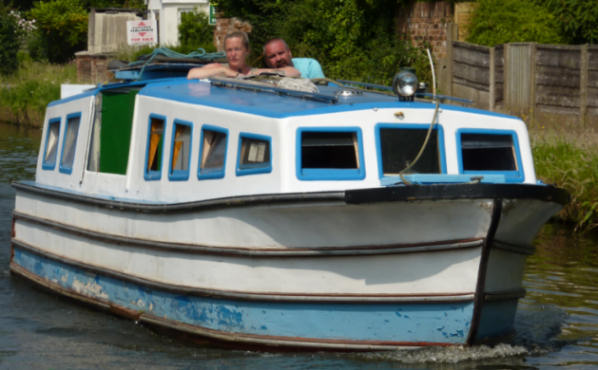
Sam Weaver's Cambrian... still going strong at over fifty years old
In the 1970s, British Waterways had a love affair with the GRP boat builder Morgan Giles of Aynho Wharf near Banbury on the Oxford Canal. They purchased many of their GRP boats and used them within their hire boat fleets at various locations. They were forty one feet in length, were built in either aft or centre cockpit versions, possessed a unique (at that time) hydraulic propulsion system known as the Hydrostatic Marine Drive which allowed an extremely quiet and flexible engine installation. They were constructed from ultra-thick glass fibre which gave both the hull and superstructure extremely durable qualities allowing them to weather the rigors of the hire boat fleet. Many examples were also built for private customers and the design was refined over the years but today there are not many examples left and when they come on the market demand quite a high price.

This is an early version, aft cockpit Morgan Giles cruiser...

... and a later version, aft cockpit Morgan Giles cruiser
This Fibreline 45 is not as beautiful as its name suggests
The Fibreline 45 was marketed as a GRP narrowboat but it was not made in huge quantities possibly due demand being stifled by the unflattering design. Below the waterline was a different matter as a revolutionary hull design incorporated two fins which funnelled water towards the propeller to increase efficiency, aid straight-line steering and act as struts similar to full-length bilge keels when the boat was slipped or dry-docked. Another GRP narrowboat-style cruiser is Popalong shown below. It is about twenty feet in length and appears to be powered by an inboard engine. The builder is unknown but the design is more aesthetically pleasing than the Fibreline illustrated above.

Popalong... a GRP narrowboat-style cruiser that is more aesthetically pleasing than the Fibreline 45
Other glass fibre cruisers of note are...
Dawncraft's 20ft "Dandy" was a compact, cathedral hulled cruiser which brought canal cruising to thousands of people with their well laid out design and economical price tag. Not many 20ft boats will sleep four in comfort (two berths were "tunnel bunks"... bunks in tunnels that ran below the rear deck) and offer all the usual amenities such as a separate toilet compartment and fitted kitchen complete with a cooker that possesses an oven. As usual with this type of boat, motive power was by outboard motor and the "Dandy" could be propelled extremely well by a Honda 7.5 horsepower motor, with 6m.p.h. easily achievable as seen in the photograph below.

This Dawncraft Dandy was mine... "Misty Waters 2" complete with a non-standard cockpit roof
The "Dandy" is extremely manoeuvrable, steers a straight line, is not effected too much by side winds and with having a standard hull draft of about 6 inches was easy to moor. I found that the boat's excellent handling was enhanced by adding ballast in the bow and a good-sized rudder on the outboard. During the late 1970's Dawncraft experimented with a new "Seagull" propulsion unit that was basically an outboard fitted to the bottom of the hull and could be turned through 360° alleviating the need for a reverse gearbox. The experiment could not have been a great success as I have never seen one of these units installed in a "Dandy" and the only one that I have heard of was offered as a competition prize in "Canal and Riverboat" magazine (yes I did enter and no I didn't win). It was once said that there were not many canal boaters during the 1970's and 80's that had not owned a "Dandy" at some time... me included!

Another Dawncraft "Dandy" that has been well restored and aptly named
Dawncraft's 29ft Rover was similar to the "Dandy" in many ways possessing a layout that was also economical of space but offering six berths. It had a conventional hull with a bluff bow above which was a sundeck. The "Rover" was reincarnated into the 32ft Highbridge Crusader by ex-Dawncraft employees when the company went into bankruptcy. The extra length was in the rear deck allowing a more conventional inboard engine installation (or storage space beneath if an outboard motor was fitted) as well as providing a spacious rear deck. These boats were nicknamed "plastic narrowboats" due to the design similarities with steel narrowboats. They also produced two smaller models in 27ft and 24ft lengths. I can remember seeing a steel version of the Rover at Kinver on the Staffordshire and Worcestershire Canal in 1985 and suspect that it may have been the prototype for a longer production run.

A 29ft Dawncraft Rover
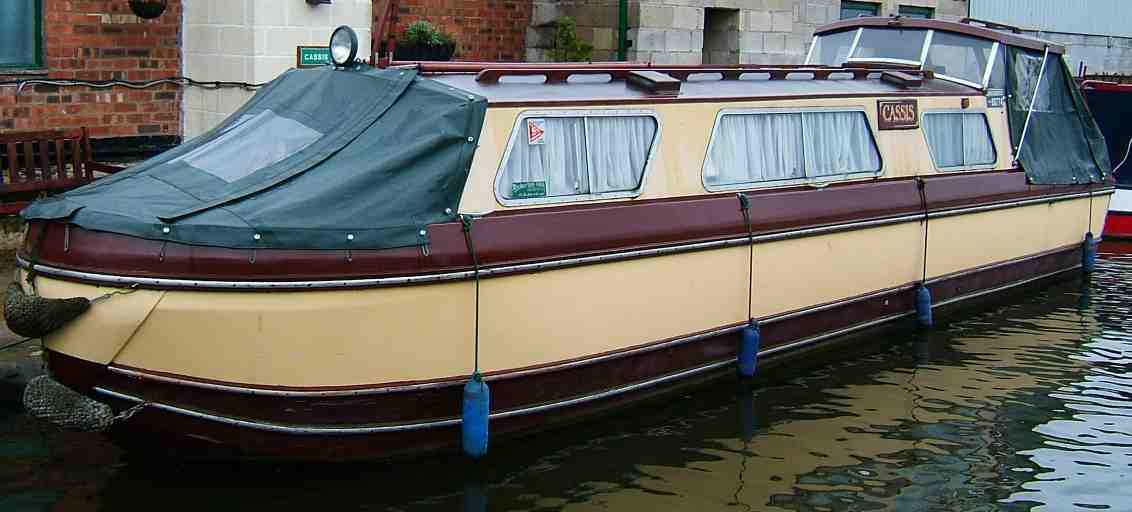
The almost identical 32ft Highbridge Crusader... spiritual successor to the Dawncraft Rover

This 27ft Dawncraft is in the process of being restored by an enthusiastic owner
Dawncraft also made boats in lengths such as 22ft, 24ft, 27ft (produced in centre and rear cockpit designs the aft cockpit version was also known as the "Sunseeker" and was a 24ft model with a larger rear deck), 32 and 37ft lengths usually in centre cockpit configuration. Dawncraft's biggest competitor was Norman. They built a similar range of boats over the same period starting with the "20", aft cockpit cruiser with a nicely proportioned centre-cockpit version known as the "Conquest."

The 20 ft Norman Conquest
The most popular Norman was the "24." Introduced in the 1970's it was refined and face-lifted over the years and even today many of these cruisers survive. As with the "20", a centre cockpit version was produced as the "27". Norman made quite a few different versions of their designs including wide-beam versions for river and estuary use, many of which were exported (we even saw one in Majorca). These versions usually had inboard engines coupled to Enfield "Z Drives". These propulsion units were basically the bottom half of an outboard motor coupled to an inboard engine. Callumcraft built boats very similar in design to the earlier Normans and could quite easily be mistaken for them.

An older version of the Norman "24"...

And a later version of the Norman "24"

A Norman 24 that we came across in Alcudia, Majorca

The centre-cockpit version of the "24" was the "27"
Whilst most of the GRP craft are powered by outboard motors some designs were suited to having inboard engines installed with either a conventional gearbox and stern gear arrangement or an inboard/outboard unit such as the Enfield "Z Drive" as seen on most Nauticus 27 craft. Originally mated to Ford "Watermotor" power units derived from Ford Anglias and Cortinas many have now been replaced with Diesel engines in the interests of safety and economy. A less popular alternative to the petrol fuelled outboard motor is the Ruggerini F15 Diesel outboard motor.
|
|
|
The ubiquitous four-stroke Honda 100 on the left and the Ruggerini F15 Diesel outboard on the right

"Xai Xai"... A classic Dobson cruiser attending the 2005 IWA National Rally at Preston Brook
Whilst attending the IWA National Rally at Preston Brook in 2005 I photographed "Xai Xai"... a classic Dobson cruiser featuring a GRP hull with a timber superstructure. The hull is similar to that of "Superbo" (below) which is not surprising as both hulls were manufactured by Bournecraft of Nottingham.
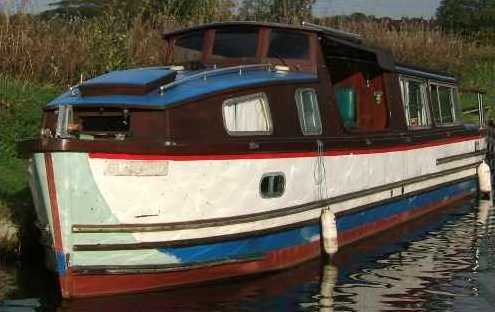
"Superbo" is a nice example of a 1960's Bourne/Flag Line centre cockpit cruiser
When I first saw the cruiser above I thought that it might be a Dobson or a Holt-Abbot cruiser but when I contacted the owner he informed me that the hull was built by a firm of boat builders called Bournecraft of Nottingham who, as well as constructing the GRP hulls for later Dobson cruisers also built the lifeboats for the Cunard ship RMS Queen Elizabeth and the SS Canberra. The superstructure and fitting out were completed by Flag Line Cruisers also of Nottingham. On our 2010 cruise along the Llangollen Canal we saw another two Dobson cruisers which are shown below.

"Fleur D'Eau" is a good example of a centre cockpit Dobson
"Scatterling" is very similar to "Xai Xai"

"Plover B" was built in the 1960's on the Oxford Canal

"Phial" was my parents' boat... built for them by Marlin Craft, Chester in 1966
As documented in "Canalscape Book 1 Chapter 5 - A Small Glass Vessel", my parents had a boat built in 1966 by Marlin Craft of Chester. This boat was built to a classic design and featured a timber superstructure fitted to a GRP hull. This design, whilst economically practical shared with most boats of hybrid construction a propensity to leak where the hull and superstructure join.
A good example of a restored Fairline 19
As a teenager in 1967 I was involved in the making of an amateur film called "Campbell at Coniston" about Donald Campbell's world water speed record on Coniston Water by John Lomax, a friend from Wirral Movie Makers of which I was secretary. Campbell's support boats were two Fairline 19s. One had an inboard engine and the other was outboard powered. Quite often one sees examples of this quality GRP cabin cruiser in varying levels of condition. The example seen above is a recently restored example and is a credit to the restorer.

A few examples of Creighton cruisers are still around and in good condition
The Lancashire firm of Creighton produced a range of canal cruisers along classic centre and stern cockpit lines. Larger versions even featured an aft sundeck as in the example shown above. Originally, they featured GRP hulls and timber superstructures, later changed to all GRP construction. Several hull lengths were offered from 26ft upwards as well as either inboard, outboard or stern drive propulsion units coupled to petrol engines in earlier models later changed to diesel engines such as the ever-popular BMC 1500 (also known as the BMC "Captain"). They were also reincarnated over the years and known by various manufacturers' names.
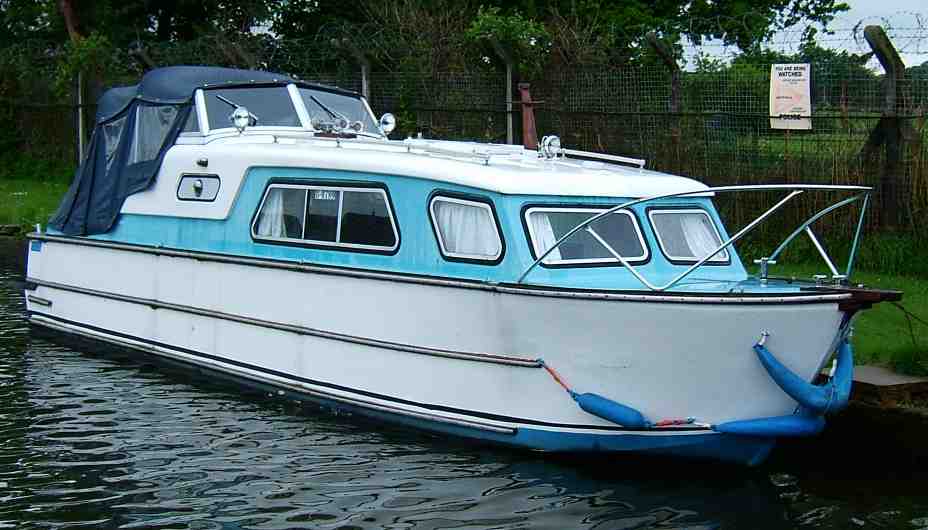
"Hideaway" is a beautiful example of the Nauticus and is a credit to the owner
The classic glass fibre cruiser of all time has to be the Nauticus 27. These beautifully constructed craft featured Ford petrol or Perkins diesel engines mated to Enfield "Z Drives" and make a distinctive sound (even when converted to diesel) that can be identified at quite a distance. The company also built a compact 22 foot version propelled by outboard motors but they are quite rare.

A rare example of a Nauticus 22
It is a pity that a centre-cockpit version was never made as this would have been the equivalent to a GRP. Taylor. The hulls were later used in the construction of the Viking range of GRP cruisers and later modified for the longer models.
Wilderness Boats Beaver 23
The Wilderness range of GRP cruisers are relative strangers to the northern waterways. They were originally built in Wiltshire and these easily trailable boats are more popular on the southern waterways. Wilderness produced boats ranging from 18 feet in length up to 23 feet in various guises and are renowned for the spacious (for their compact length) interior layouts. The example illustrated is unusual as it has been fitted with a rear deck canopy. A fire in 2000 damaged the GRP moulds and no new craft have been built since then. However, a new company called Wilderness Trailable Boats has been formed. The new company has reconstructed the original moulds, redesigned the interior and added new eco-friendly features such as a roof mounted solar cell and LED lighting inside the cabin.

An Ormelite in good condition at Stretford on the Bridgewater Canal
The Ormelite was a popular favourite during the late 1960s and 1970s as both private and hire craft. There are not many examples left of these centre cockpit cruisers that featured an unusual sliding cockpit roof that provided a warm, dry steering position regardless of the weather. This company also designed and produced the glass-fibre superstructures for Shropshire Union Cruisers' "Frobisher" class narrowboats of which some models also featured a sliding roof over the cockpit.
A nice example of a Charnwood 25
Charnwood built boats similar to the Ormelite inasmuch as they were both possessed GRP hulls and had sliding roofs over a centre cockpit but were a little more stylish in their design. As well as the "25" shown above they also made a compact "18" and "22" centre cockpit models but the smaller models did not possess the sliding cockpit roof Later models like the alleged (it does have a Charnwood badge on it) "22" pictured below were of 100% GRP construction.

A centre cockpit cruiser allegedly a Charnwood 22
"Tug"... a restored 1970's "Ten-16-20"
The "Ten-16-20" was very popular 20ft, aft cockpit cruiser in the late 1960s and 70s and was even used as a hire boat by Ladyline. It featured a bluff-bowed "Seacrete" hull which was made from a form of waterproof concrete spayed onto a mould and reinforced with chicken wire, not only to add strength but to help it keep its shape whilst curing. Concrete may seem an unusual material from which to make boat hulls due to its density and weight but over the years there have been many designs with different levels of success that utilised this material. During the Second World War many barges and even some narrowboats were constructed from this material.

This unusual concrete hulled cruiser moored near Worsley on the Bridgewater Canal (you can tell by the colour of the water) is in need of a little "TLC"

A World War Two concrete barge preserved at the National Waterways Museum - Ellesmere Port (formally The Boat Museum)
Another of my favourite designs was used by two hire cruiser companies... Shropshire Union Cruisers at Norbury Junction and the Bunbury Boat Company (later Dartline). They were later to become sister companies and both were based on the Shroppie. At first hey used wooden “Walton” hulls built in Birmingham (complete with superstructures) that had traditional narrowboat construction (oak on elm) and fitted out the cabins themselves. One such craft was the “Marco Polo”, a thirty five foot, six berth hire boat that was based at Bunbury. It had an air-cooled Lister diesel engine, centre cockpit with a windscreen, collapsible roof and canvas side-covers. There were others in the fleet that were smaller or longer but none of them had the balance of design that the “Marco Polo” possessed.

The "Rose of Sharon" was one of the first leisure narrowboats to feature a "Cutlass" steel hull
This particular boatbuilder later changed to steel in the shape of the “Cutlass” hull and fitted timber cabins on what was a predecessor of today’s narrowboat as is documented in the photograph of the "Rose of Sharon" (as owned by Dr David Owen and Iris Bryce... the canal book authors). They then graduated to glass-fibre superstructures and one of their designs was the six berth “Frobisher” class narrowboat. This design possessed a cruiser stern and some models had wheel steering from a position aft of the forward cabin. The forward part of the rear cabin roof was on slides and slid back to provide a large sun roof (weather permitting) and to improve visibility when steering from the wheel position. There are also a couple examples of the “Frobisher” design made in all-steel construction. Later craft had conventional steel superstructures but none possessed the well-balanced lines of the “Marco Polo”.
An example of a Frobisher narrowboat complete with sliding roof section
A later example with a conventional layout

NB "Bunbury Belle"... one of the best examples of a Bunbury Boat Company/Shropshire Union Cruisers around
Another company that built steel narrowboats and fitted them with GRP cabins was Canal and Rivercraft and it is a tribute to the builders that so many of these venerable craft are still going strong.
A good example of a Canal and Rivercraft narrowboat
Around this time, a firm on the Leeds and Liverpool Canal called “Dalescraft” started making steel hulled canal cruisers. At first their boats possessed glass fibre superstructures but later examples had steel ones and, depending upon the length could accommodate up to eight berths. They are renowned for their heavy build and unique bluff bows. Lister diesel engines were fitted and they usually gave the impression of “working hard” due to the design of the hull and weight. The company also produced a light weight, glass fibre, four berth cruiser that was basically a centre cockpit design fitted with a sliding reef similar the Shropshire Union’s “Frobisher” class of boat. They were propelled by outboard motors and a few are still in regular use today.

A rear cockpit Dalescraft... Also available in centre cockpit

This GRP Dalescraft has seen better days and is in need of some "TLC"
A company that enjoyed a great deal of success from the 1970's to the 1990's was Springer Engineering. They produced a range distinctively designed narrowboats ranging from twenty feet to sixty-five feet in length. The most obvious feature was the splash guard fitted to the join between the bow and the foredeck. A less obvious feature was the "V" shaped hull. Most narrowboats are flat bottomed but, in an attempt to allow their craft to moor closer to the bank in shallow water the "Springer" had a shallow "V" shaped hull. As if to mirror this the cabin roof has a slight "pitch" to it allowing rainwater to run off and not collect in one place. Unfortunately, the welding on some of these craft left a little to be desired cosmetically (although they were well constructed) and were fabricated from thinner than normal steel to keep costs and weight down. Even so there are plenty of these craft around and they have most certainly stood the test of time.

An early Springer showing the distinctive splashguard on the bow
The Springer "Water Bug" was a compact twenty foot narrowboat designed for the budget conscious and powered by an outboard motor. A slightly longer version incorporated a small inboard diesel engine. The example illustrated... "Cushy Butterfield" belongs to my cousin Lucy Folly and is moored on the Trent and Mersey Canal near Stone.
The diminutive Springer Water Bug was usually powered by an outboard motor
This Water Bug has been fitted with an unusual forward steering position and front deck
A boat that was similar in concept to the Springer Water Bug was the Owl Class narrowboats built by Mick Sivewright at Barbridge Junction. They shared the overall design concept but were usually fitted with a small inboard diesel engine and not an outboard motor like most of the Water Bugs. Both of these designs are no longer produced but compact narrowboats are still built, the latest being the Aintree Beetle built by Aintree Narrowboats in Liverpool.
An Owl Class narrowboat built by Mick Sivewright at Barbridge Junction

The Aintree Beetle compact narrowboat built by Aintree Narrowboats in Liverpool
This centre cockpit cruiser is based on a narrowboat hull by Bridgewater Boats
Another modern trend in canal boat design is the wide-beam narrowboat. Basically, as its name suggests, a narrowboat but built to a wider beam of anything from eight feet to fourteen feet beam. This design allows more space inside and is ideal for live-aboard boaters and continuous cruisers. The downside of this design is that the waterways available to cruise are restricted to broad canals, rivers and other inland navigations but their extra width is well suited to those wishing to brave tidal waters.

A typical wide-beam narrowboat... this example was built by Collingwood Narrowboats
A modern narrowboat development is the "Sea Otter" narrowboat. This light weight, trailable (dependant on length) narrowboat is constructed from marine grade aluminium to make them light in weight and hence trailable although a 4x4 or heavy, powerful vehicle is required to tow them in safety. Another weight saving innovation is the inclusion of ballast tanks that fill when with canal water when the boat is launched and empty when slipped. This system negates the need for heavy ballast in the shape of concrete or steel ingots. Sea Otters are usually powered by Diesel engines and conventional stern gear in the usual way. The example illustrated below was photographed in France when we were travelling to the River Rhine. Another Sea Otter of note was the smallest narrowboat I have ever seen (at twenty one feet long) a photograph of which is also included below.

A "Sea Otter" aluminium narrowboat
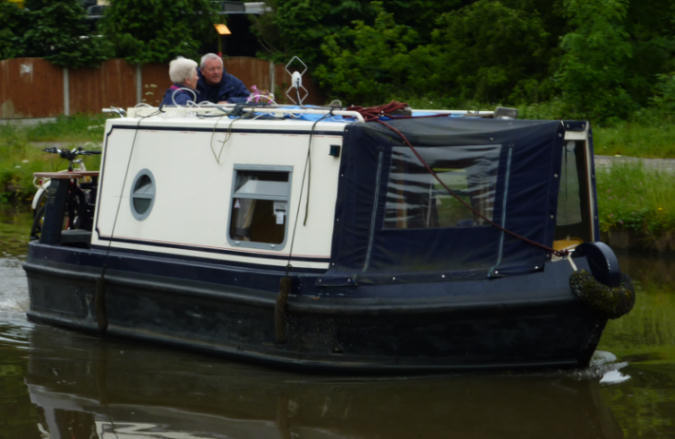
The smallest narrowboat I have ever seen... a 21ft Sea Otter
NB "Phoenix" is an experimental design of narrowboat that is a statement of a modernistic boat constructed to a money no object brief and reputed to have cost in excess of £225,000. There have been many articles written about this boat conventionally powered boat and love it or hate it one must certainly agree that it is most certainly different!
 |
 |
 |
Love it or hate it... nb "Phoenix" is most certainly different (it should be for £225K!)
A type of boat that has become increasingly popular in the last few years is the day hire narrowboat. These conventionally constructed narrowboats are usually shorter than most at around thirty feet and usually lack sleeping accommodation. Most canal hire boat companies possess at least one example as they offer an inexpensive "taster" to canal cruising. Especially if the cost of hiring is split between about ten people.

Thorn Marine's "Wandering Thorn" is a good example of a day hire narrowboat
A craft that we saw quite often on our travels during the 1960’s was a privately owned centre-cockpit cabin cruiser called “Antwerp”. She was similar in many respects to a Taylor built boat called the “Jenny Wren” although the owners informed us that she was built on the River Weaver at Weaverham. The timberwork on “Antwerp” was all varnished mahogany with the exception of the cabin roofs, gunwales and below the water line. If memory serves me correctly, she was powered by a Volvo Penta inboard petrol engine, the first time we had come across this manufacturer. We saw the boat quite often on our travels and I was to come across her again, many years later, moored on the Bridgewater Canal at Walton, adjacent to the A56 “toast-rack” road bridge. Unfortunately, she was broken-up and burnt in the mid 1990’s as she was suffering from a considerable amount of rotten timber. Her owners went on to have a Springer narrow boat originally christened “Thumper” which was complete with a painting of Walt Disney’s famous cartoon rabbit from “Bambi” with his foot in the air ready to “thump” the ground, after which the boat’ was named (the Lister engine may also have had something to do with the name as well). Coincidentally, we have seen another “Thumper”... also a Springer. It used to be moored at Beeston Castle Wharf but now resides on the linear moorings at Calveley above Bunbury Staircase Locks on the Shroppie.
Heart of Oak
An unusual Bridgewater Canal "resident" is "Heart of Oak"... no relative to the Walton craft featured later. This diminutive craft is usually moored at Thelwall and is thought to date from around 1910 and at one time may have been a divers' boat on the Manchester Ship Canal as it is very low in the water due to it being very heavily built. It has recently changed hands and its new owner has spent some time (and no doubt... money) restoring the exterior. It has also been refitted inside and is looking very smart indeed.
As well as the conventional designs mentioned there are always boats that stand out from the crowd due to design eccentricities. I can remember seeing two “stern-wheelers” during the early 1960’s. Both these boats had stern-mounted paddle wheels driven by petrol or diesel engines and would not have been as susceptible to weeding up as conventional screw-propelled craft. The "Caraboat", as its name suggests is a small caravan which could be backed down a slipway to be launched like a small boat. Whilst afloat they are powered by conventional outboard motors and, although not particularly popular examples can be seen from time to time.
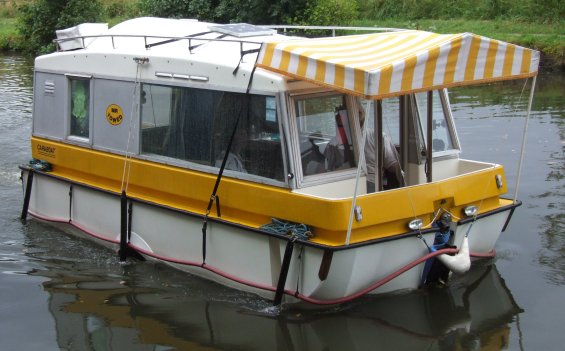
The front of a Caraboat... the towing hitch is beneath the bow fender

The rear view of a Caraboat showing a conventional Honda outboard motor
The eccentric school of thought for boat design was further explored with the "Ailona". This is a catamaran powered by a hidden outboard motor. It is usually based at Middlewich and is obviously designed to be transported by road on a trailer. I first saw it at Church Minshull on the Shropshire Union Canal's Middlewich Branch but have also seen it on the Trent and Mersey Canal.

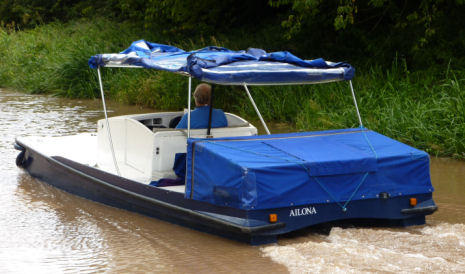
"Ailona"... an unusual outboard motor powered catamaran
Another unusual craft recently seen on the Bridgewater Canal was this pedello. Usually found in boating lakes and the sea I must say that this is the ultimate in dinghies with a green propulsion system. Being pedal powered like a bicycle means that the peddler can see where he or she is going, unlike when using oars. The also require less skill to propel correctly.

Normally found in boating lakes or the sea, the Pedello is the ultimate "green" dinghy
Pedal power t
aken a step further is the amphibious camping boat shown below. On land the boat is more of a trailer tent towed behind a mountain bicycle but on water pedal power remains the means of propulsion. It is not shown what happens to the bike when the boat is on water though. Maybe it is stowed on the roof!

Pedal powered amphibious camping boat on dry land...
(Photograph - Daniel Dumin... spotted by Paul Savage on Facebook)

...and on water
(Photograph - Daniel Dumin... spotted by Paul Savage on Facebook)
Whilst on the subject of propulsion, motive power in canal craft has varied over the years just as it has with larger craft. Narrowboats and barges were originally hauled by horses or in some cases by men and sometimes even possessed sails. Although steam powered craft had been used on the Bridgewater Canal for many years previously, around the turn of the Nineteenth and Twentieth centuries were becoming popular. Apart from seeing the Fellows and Morton Steamer “Monarch” - the twin to "President" at Preston Brook, it was not until very recently that I saw a narrowboat cruising along the Trent and Mersey Canal powered by steam as well as a replica Dutch barge replica illustrated later on that was also powered by steam that swished past us on the Bridgewater Canal, and very quiet they were too. Stem propulsion in narrowboats did not last very long and existing units were being replaced by semi-Diesel engines. "Sharpness" is a steel icebreaker tug built specifically for the Worcester and Birmingham Canal, the River Severn and the Gloucester and Sharpness Ship Canal. It is the twin to "Worcester" which still has its original single cylinder, 30 horse power Kromhout Petrol/Paraffin engine whereas "Sharpness" has had its original Kromhout engine replaced due to frost damage
with a Gardner 4L2 diesel engine built in 1932. Many ex-working boats still possess their original Bolinder, National, Russell-Newbury or Lister engines. Whilst looking after them (and starting some types) may be a labour of love the exhaust note that they produce is an audible reward and one of the most emotive sounds found on the inland waterways system.

"Monarch" the twin to "President" at Preston Brook

The icebreaker tug "Sharpness"... Twin to "Worcester"
Another tug worthy of mention is the "MSC Frodsham", a replica of a Bridgewater Canal Tug (although they could quite often be seen towing barges on the Manchester Ship Canal). This craft was first seen at the 1988 IWA Rally at Castlefield on the Bridgewater Canal. Outwardly it is very faithful to the original design but the enthusiastic boat spotter (aka the rivet counter) may find many differences between the two. I suspect that the replica does not possess the compound steam engine and 36inch propeller of the original Bridgewater design. It is usually moored on the Shropshire Union Canal at Stretton. "Reina Del Rio" is a replica tug based on the Severn and Canal Carrying Company's tug "Severn Progress" which is a long-term resident at the Gloucester Waterways Museum and now in British Waterways livery.

The "MSC Frodsham" is a replica Bridgewater Canal tug...

... as is "Turnothworld"...

| ... and this is the real thing. The "MSC Walton" photographed |
|
on the Manchester Ship Canal at Ellesmere Port (Photograph - Manchester Ship Canal Company) |
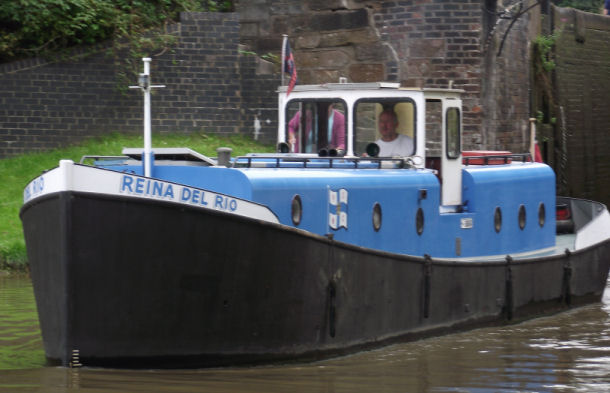
"Reina Del Rio" is a replica Severn and Canal Carrying Company tug
(Photograph - Oliver Savage)
I often wonder what has happened to some of the boats that we encountered over the years. The fate of some of them we know such as “Juliana”, “Water Violet” and “Water Lupin”, “Jenny Wren” and some of the other Taylors. It is coincidental that quite a few of the craft mentioned end up on the Bridgewater Canal... “Exodus” as previously mentioned was at Runcorn but I think has now been broken-up, “Antwerp” was also broken up at Runcorn, I remember seeing Dean’s “Willeymoor” sunk close to the location of Runcorn Gas Works in 1987 and has now been broken-up, “Barbara Joan” was out of the water at Stretford Boatyard where it had been for many years and has now gone to a boat yard that specialises in wooden boat restoration. At the same location is was boat that could have been the “Marco Polo” but has now sadly been broken up. Another wooden craft once christened "Lady Aron" that was built by the “Little Ship” boat builders of Oulton Broad, Suffolk (nothing to do with the Dunkirk “Little Ships”) is very similar in design to the Maid Line craft of the 1950s and 1960s designed by Captain Lionel Monk... one of the founders of the Inland Waterways Association. This boat is 29ft long by 9ft beam and is now at the Lorenz Boatyard in Leigh awaiting restoration.

Possibly the remains of "Marco Polo" being broken up at Stretford in 2005

Another Walton Cruiser "Heart of Oak"... one of the few remaining recently seen on the Bridgewater Canal

A couple of weeks later we saw "Heart of Oak's" sister... "Flycatcher" at Lymm

The Little Ship "Lady Aron" during her heyday in the 1970s...
(Photograph - Lymm Cruising Club Archive)

... and more recently looking very much the worse for wear at Stretford in 2004
In today’s uniformity of design and mass production, the distinctiveness of older, individually constructed craft has been lost except for the occasional sightings of classic Dobson, Holt-Abbott or Taylor cruiser or replica Dutch Barge. Having said that, the modern narrowboat canal cruiser has a design perfected over the years, features and facilities that anyone cruising the canals in the 1960’s could only dream of and it will be interesting to see what the future holds in this direction.

"About Time" is a replica barge large enough to live on (nice scumbling)
|
|
|
|
The above are also Dutch Barge replicas. The one on the left is a wide-beam replica whilst the one on the right is a |
|
narrow beam, steam powered replica. Both are fitted with collapsible wheelhouses for passing beneath low bridges |
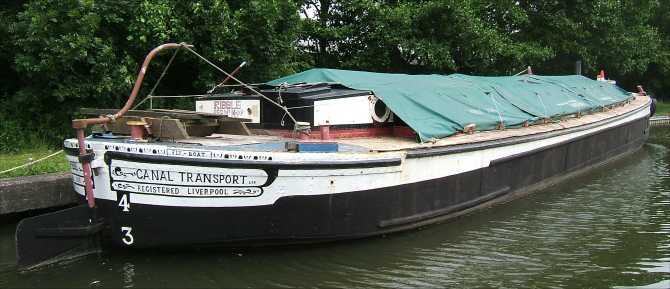
This, however is the real McCoy... a Leeds and Liverpool Canal Short Boat
This unusual craft is reminiscent of a Tjalk... a type of Dutch barge with a shapely bow
Modern narrowboats come in four basic types...
The Cruiser Stern as its name suggests possesses a stern that is open, usually housing the engine beneath the floor and has a large space for sitting out whilst cruising. There is a growing trend for a canopy and windscreen to be fitted to make all-weather cruising a more pleasant experience. I know of one resourceful boat owner who has fitted a radiator (complete with circulation fan) heated from the engine's cooling system to warm the rear deck area when covered in cold weather. Some enterprising owners fit unusual rear deck wheelhouses (colloquially known as "sheds") to their cruiser stern narrowboats. The narrowboat "Isychia" features a Land Rover "Defender" hard top complete with spare wheel although I personally think that a life belt would be more appropriate.

The spacious cruiser stern of a Hancock and Lane "Norseman 40"
NB "Isychia" features an unusual rear deck cover from a Land Rover Defender
The Traditional Stern is copied from the working narrowboats that used to carry cargo around the canal system. This type of stern is usually deemed anti-social due to the fact that only a couple of people can keep the steerer company at any given time due to the small size of the rear deck. Many traditional style craft have a replica "Boatman's' Cabin" at the stern and an engine room as well. To compliment the traditional stern a "Josher" bow should be fitted. This type of bow has a shapely double curve to promote good "swimming". The term "Josher" emanates from the Fellows Morton and Clayton Carrying Company and designed by Joshua Fellows... one of the founders of the company. There is a modern trend for dummy rivets to be welded onto the boat's hull and in some cases even the superstructure to simulate the look of the old working boats. They are mockingly known as "Washer Joshers". I dislike this practice as it leads people to believe that the boat is something that it is not... but that is a purely personal point of view and I am sure that there are plenty of people (especially those who own boats featuring dummy rivets) who will disagree with me. As with the "Cruiser Stern", some craft have a small canopy to protect the steerer in unpleasant weather whilst others rely on waterproof clothing and hats or umbrellas.
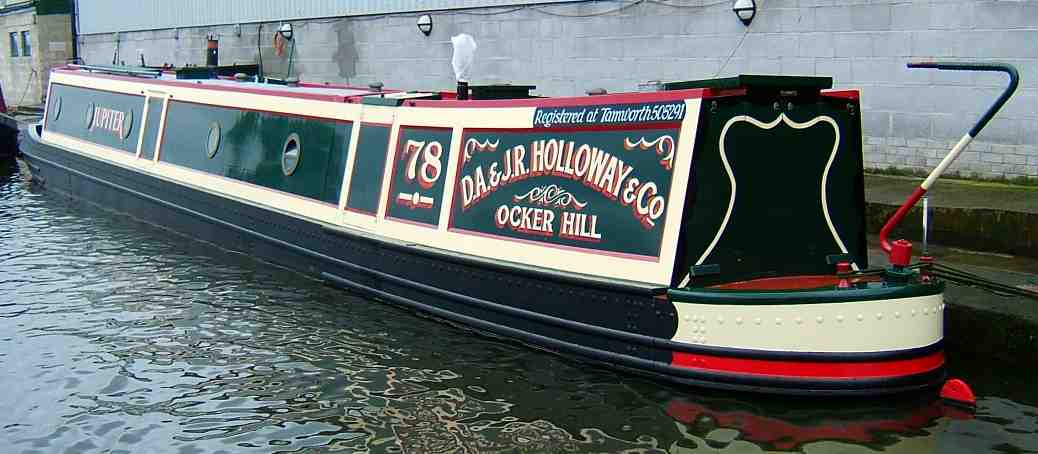
The Semi-Trad Stern is a hybrid of the Cruiser and Trad sterns giving the functionality and space of the "Cruiser" with the look and protection of the "Traditional" stern (provided that the back doors are closed). Due to higher manufacturing costs this design is not as popular as the other two but more and more examples are finding their way onto the market and option lists of many boatbuilders.

An unusual hybrid of the semi-trad and cruiser stern is illustrated here in this Bronowski built narrowboat. It features a fixed wheelhouse over the semi-trad rear deck with an under cover wheel steering position for inclement weather and also has a short rear deck with a conventional tiller.
A Bronowski narrowboat with a fixed wheelhouse
This unusual stylish cruiser was built by Arkright Fabrications of Corby possibly known as a "Sunseeker"
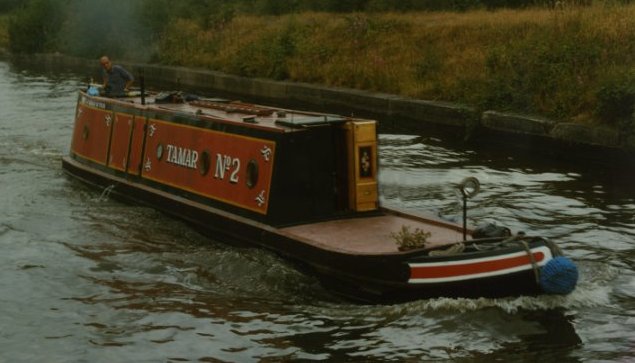
The final type is the Tug Replica. This is a modern reincarnation of the B.C.N (Birmingham Canal Navigations) tug (although similar designs were used on other canals). These are usually deep-drafted craft with a large front deck with storage, ballast or even an additional bed beneath. The standard length is 48 feet long although they could be (and are) constructed to any length. A large classic-type engine such as a Russell Newbury, National, Gardner or big Lister usually lives in its own engine room. As with a traditional stern boat dummy, rivets may be fitted to replicate the look of genuine ex-working boats.

|
Dummy rivets adorn many replica working boats can look very convincing |
|
This particular boat is an S M Hudson |
There is a fifth type but is not technically a narrowboat. This is the Wide-Beam narrowboat, the name of which itself is a contradiction of terminology. These boats are basically a narrowboat design but with a wider beam. The beam of the craft are anything from 10 feet to 14 feet. Not every canal can accommodate this type of craft, consequently, the canals that they can be used on or reach is limited. They are also considerably more expensive than their narrow beam counterparts (but currently pay the same licence fee as a narrow beam boat of the same length).

Becoming more popular on broad canals is the Wide-beam Narrowboat

"Fur Elise" is an expatriated Broads Cruiser seen here on the Bridgewater Canal
Another type of broad beam cruiser not normally seen on the canal network but worthy of mention here is the Broads Cruiser. Normally seen on the Norfolk Broads and rivers such as the Thames they can be used successfully on broad canals but unfortunately their cruising range does not include the narrow canals of the North and Midlands of England or the Welsh canals. "Fur Elise" (pictured above) is a "Caribbean 39" built by F B Wilds of Horning, Norfolk. She is 39ft long by 12ft beam and was one of the first "forward control" cruisers.
Environmental considerations may cause diesel engines to be replaced by more environmentally friendly power sources. In the 1980’s, hire boat companies played with electrically powered narrowboats with huge battery banks which required charging daily from landlines provided at a few locations along the canal but this idea died a natural death most probably due to hirers not charging sufficiently, the designated charging berths not being available or the hirers just not bothering to charge the battery bank when required. I think that, once the technology has been perfected, the future lies with high efficiency solar cells charging the domestic batteries and fuel cells driving an electric propulsion motor. This system is already being experimented with by some major car manufacturers and at least one boat builder. British Waterways also have a prototype workboat being evaluated that runs off a fuel cell. But, we will have to wait and see if my prophecy actually happens. I don't think that it will occur in my lifetime though!
So there you have it... a potted history of the canal cruiser from converted narrowboats, barges, pontoons and lifeboats to purpose built cruisers, narrowboats and barges. It has been said that today's leisure narrowboats lack the character and diversity of design that cruisers possessed fifty years ago when I started canal cruising with my parents. This may be true but every so often a boat comes along that dispels this view. Such a boat is "U8047"... a narrowboat with a superstructure that resembles a Second World War German U-Boat... complete with conning tower and torpedo tubes. This unique boat was launched on the Leeds and Liverpool Canal at Botany Bay in October 2010. I wonder what the Boat Safety Certificate Examiner thought about those features?



"U 8047" on the Leeds and Liverpool Canal
(Photograph - Daily Mail)
or select another book below...
 |
|
"Canalscape" and "Diarama" names and logo are copyright |
Updated 09/07/2017